RUI: Microbiological Survey and Inventory: Eugregarinida (Protista: Apicomplexa) Parasitizing Selected Mandibulate Arthropods of the Nebraska Sandhills
R. E. Clopton, Principal Investigator
NSF Award ID: 9705179 (05/1997-04/2001)
Project Goals and Objectives
The goal of the project was to conduct a survey and inventory of gregarines parasitizing selected arthropods of the Nebraska Sandhills. The project had 6 objectives:
- Survey the gregarine parasites of selected Sandhills arthropods by collecting host arthropods and isolating their gregarines
- Identify and describe collected specimens by building a reference collection of host taxa and preparing taxonomic descriptions of their gregarines
- Develop new character suites for gregarine diagnosis and description by examining characters revealed by a variety of microscopical techniques in a diverse sample of gregarine taxa
- Train my undergraduate research colleagues in protozoan systematists through complete participation in all phases of the project
- Establish the nucleus of a gregarine research collection by preparing and depositing type and voucher specimens of gregarines and their hosts, establishing tissue collections of gregarines for future biochemical and genetic analysis, and making the project database available through the INTERNET via the WWW
- As an RUI grant, my primary integrated objective was to provide compelling mentored research experience for undergraduate students at Peru State College
Research and Education Activities
Undergraduate training
The project has provided a compelling mentored research experience for 13 undergraduate students at Peru State College. All of these students have fully participated in the collections, preparation and analysis phases of the project and 5 of 13 have gone on to pursue collateral work in gregarines or protozoan systematics with the project. Nine of the project's students have graduated and of these, 2 have advanced to medical school, 1 to veterinary school, 1 is now a secondary science teacher, 1 is a research technician in insect pathology at the University of California, and 3 have advanced to graduate school (1 has completed the MS and entered a PhD program in systematics, the other 2 are MS candidates in wildlife or microbiology.) Three of the project's students are still attending PSC and conduct a variety of research programs within the department including survey of protozoan (coccidian) parasites of freshwater fish, protozoan (coccidian and isoporan) parasites of fox squirrels and red-winged blackbirds, and chemotherapeutic control of gregarine parasites in insects. In all 85% of the project's students have made life choices based on their early research experience at Peru State College.
Field Collections and Biodiversity Discovery
Field collections were made and specimens processed during 3 10-wk periods, (ca. June-August, 1997-2000). Additional focused collections were made during a 5-wk period in June-July 2001 to complete data sets on several new gregarine taxa.
The project collected and provided sub-familial identifications for 5,432 individual arthropods. The arthropod survey consists primarily of insects representing 38 families across 10 orders but includes a number of arachnid specimens representing the harvestmen (Opiliones). The survey focused on 3 insect orders: Coleoptera (recovered 16 families, 73 species, 2,929 individuals), Odonata (recovered 6 families, 27 species, 1,160 individuals) and Orthoptera (recovered 6 families, 24 species, 1,016 individuals). 1,258 host specimens have been curated as permanent voucher specimens and are being deposited in reference collections at the University of Nebraska State Museum, Cedar Point Biological Station, and Peru State College. 152 host guts have been preserved for future histological examination of host parasite tissue interfaces. Oocyst samples from over 30 taxa have been preserved for examination under electron microscopy.
Over the span of the survey, 140 host species were surveyed for gregarine infection. Postmortem examinations were conducted on 3,104 individuals of which 1,511 hosted at least 1 gregarine species (overall gregarine prevalence = 49%). Parasite genetic samples from 142 hosts were collected and distributed to other laboratories upon request. Analysis of gregarine specimens is on-going, but to date we have identified 66 putative gregarine taxa of which 72% are previously unknown: 6 families (1 previously unknown), 17 genera (5 previously unknown), and 49 species (42 previously unknown). 1282 permanent slide preparations of new and known gregarine taxa were produced and are being processed for deposition at the University of Nebraska State Museum and Peru State College.
Outreach Activities
I regularly give talks to public groups (Kiwanis and Optomist Clubs, the public nature centers, K-12 science classes, etc.) My talks tend to focus on biodiversity, the role of invertebrate diversity in human life, the importance of basic science in American society, and the role of NSF as a funding agency for basic science.
Permanent Collections
New primary collections. The primary product of this project is the permanent collection of host and parasite specimens produced during the survey. As of August 2001 approximately 3,540 permanent specimens of hosts or parasites have been produced. These specimens are being deposited at the University of Nebraska State Museum for loan to other researchers. Aquisition, curation, and deposition of existing collections. The family of R. Ormieres has contacted me through the project's WWW site and has offered to donate the late R. Ormieres' extensive personal collection of European gregarines and gregarine literature. R. Ormieres' brilliant but short career in gregarine systematics was ended by a fatal cerebral embolism almost 20 years ago. Although his work is known and respected, his extensive personal collections were assured lost. I have imported this resource to the United States for analysis, curation, and deposition in the University of Nebraska State Museum.
Publications
Clopton, R. E. 2006. Two New Species of Xiphocephlaus in Eleodes tricostata and Eleodes fusiformis (Coleoptera: Tenebrionidae: Eleodini) from The Sandhills of Western Nebraska. Journal of Parasitology 92: 569-577. PDF
Clopton, R. E. 2004. Standard nomenclature and metrics of plane shapes for use in gregarine taxonomy. Comparative Parasitology 71: 130-140. PDF
Clopton, R. E. 2004. Calyxocephalus karyopera g. nov., sp. nov. (Eugregarinorida: Actinocephalidae: Actinocephalinae) from the ebony jewelwing damselfly Calopteryx maculata (Zygoptera: Calopterygidae) in southeast Nebraska: implications for mechanical prey-vector stabilization of exogenous gregarine development. Comparative Parasitology 71: 141-153. PDF
Clopton, R. E., T. J. Cook, and J. L. Cook. 2004. Naiadocystis phykoterion n. gen., n. sp. (Apicomplexa: Eugregarinida: Hirmocystidae) from the mexican pygmy grasshopper Paratettix mexicanus (Orthoptera: Tetrigidae) in the Texas Big Thicket with recognition of three previously described species of Naiadocystis. Journal of Parasitology 90: 301-307. PDF
Clopton, R. E. 2004. Comparative Parasitology policies and instructions for authors. Comparative Parasitology 70: 218-225.
Smith A., and R. E. Clopton. 2003. Efficacy of oral metronidazole and potassium sorbate against two gregarine parasites, Protomagalhaensia granulosae and Gregarina cubensis (Apicomplexa: Eugregarinida) infecting the Death's Head Cockroach, Blaberus discoidalis. Comparative Parasitology 70: 196-199. PDF
Leander, B. S., R. E. Clopton, and P. J. Keeling. 2003. Phylogeny of gregarines (Apicomplexa) as inferred from small-subunit rDNA and beta-tubulin. International Journal of Systematic and Evolutionary Microbiology 53: 345-354. PDF
Clopton, R. E. 2002. Phylum Apicomplexa Levine, 1970: Order Eugregarinorida Léger, 1900. Pages 205-288 in: Illustrated Guide to the Protozoa, 2nd edition, J. J. Lee, G. Leedale, D. Patterson, and P. C. Bradbury, eds. Society of Protozoologists, Lawrence, Kansas. PDF
Clopton, R. E., and C. M. Nolte. 2002. Clitellocephalus americanus n. gen., n. sp. (Apicomplexa: Eugregarinida: Gregarinidae) from Cratacanthus dubius (Coleoptera: Carabidae: Harpalinae) in the Nebraska Sandhills and Clitellocephalus ophoni n. comb. (Apicomplexa: Eugregarinida: Gregarinidae) from Ophonus pubescens (Coleoptera: Carabidae: Harpalinae) in Sète, France. Journal of Parasitology 88: 750-757. PDF
Clopton, R. E. 2000. Stylocephalus occidentalis n. sp.(Apicomplexa: Eugregarinida: Stylocephalidae) from Trimytis pruinosa (Coleoptera: Tenebrionidae) in the Nebraska Sandhills. Journal of Parasitology 86: 560-565. PDF
Kula, R. R. and R. E. Clopton. 1999. Amoebogregarina nigra n. gen., n. comb. (Apicomplexa: Gregarinidae) From Adult Melanoplus differentialis (Orthoptera: Acrididae) in Southeastern Nebraska. Journal of Parasitology 85: 321-325. PDF
Clopton, R. E. 1999. Revision of the genus Xiphocephalus and description of Xiphocephalus ellisi n. sp.(Apicomplexa: Eugregarinida: Stylocephalidae) from Eleodes opacus (Coleoptera: Tenebrionidae) in the western Nebraska Sandhills. Journal of Parasitology 85. 84-89. PDF
Contributions
Scientific
The project has made three important contributions to biology in general and to systematics and gregarine biology in particular. First, the project has made gregarine research systems more accessible, producing an increased interest in gregarine biology. Over a dozen new research groups/individuals (including 1 secondary school group) have begun work on gregarine taxonomy or ecology as a result of interaction and contact with my project. My project now acts as an international resource for gregarine systematics, identification, and ecology. Second, the project has begun to define a stable gregarine systematic. The project has established and disseminated standard protocols for gregarine preservation and the project's publications are quickly establishing a new standard for gregarine taxonomy and standardized methods in the scientific literature. The continued growth and development of the discipline depends upon both standardized protocols and a stable taxonomic method. Third, the project has provided new model systems for ecological and evolutionary research. All biological research depends first on a solid organismal systematic. The project continues to provide new experimental systems for the study of ecology and evolution, taxonomic identifications for other workers, and identified samples for molecular studies of protistan phylogeny.
Human Resource Development
The project provides a research training ground for students at Peru State College. The project has provided stipend support, training and independent research opportunity to 13 undergraduates students. Six of the project's students have prepared and presented platform presentations at professional meetings or have prepared and submitted manuscripts for publication. All of these students have fully participated in the collections, preparation and analysis phases of the project and 5 of 13 have gone on to pursue collateral work in gregarines or protozoan systematics with the project. Nine of the project's students have graduated and of these, 2 have advanced to medical school, 1 to veterinary school, 1 is now a secondary science teacher, 1 is a research technician in insect pathology at the University of California, and 3 have advanced to graduate school (1 has completed the MS and entered a PhD program in systematics, the other 2 are MS candidates in wildlife or microbiology.) Three of the project's students are still attending PSC and conduct a variety of research programs within the department including survey of protozoan (coccidian) parasites of freshwater fish, protozoan (coccidian and isoporan) parasites of fox squirrels and red-winged blackbirds, and chemotherapeutic control of gregarine parasites in insects. In all 85% of the project's students have made life choices based on their early research experience at Peru State College. The project and in particular the project's students set an invaluable example in a small, public, rural, liberal arts school such as Peru State College. Our students come to college with little understanding of their potential as citizens and thinkers. This project teaches them that science is first and foremost a human endeavor, that high-caliber, exciting science can be dome anywhere, not just in a major research institution, and that once they begin a career in science, it opens doors and opportunities for them in ways that they had never imagined. As a direct result of NSF support for the project, the administration of Peru State College and the Peru State College Foundation have increased their support and promotion of faculty and undergraduate research at Peru State College. We have developed a regional reputation for undergraduate mentored research and every year more of our incoming students choose to attend PSC and major in Biology in order to acquire an experiential education. The effect has been profound, such that our governing Board of Trustees has allowed us to make undergraduate research a standard teaching component of the curriculum.
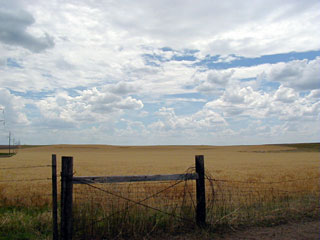
Wheat fields, Keith County, Nebraska.
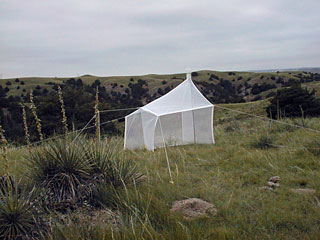
Malaise trap, hard hills formation, Keith County, Nebraska.
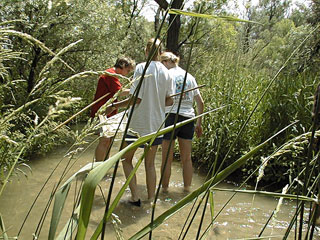
Collecting stream invertebrates, Clear Creek, western Nebraska.
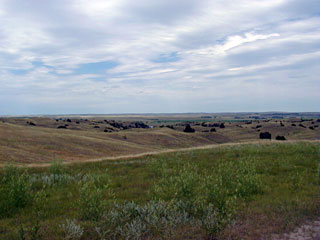
Western Nebraska Sandhills, Arthur County, Nebraska.

Bob Kula dissecting grasshoppers for gregarine survey, Cedar Point Biological Station, Keith County, Nebraska.
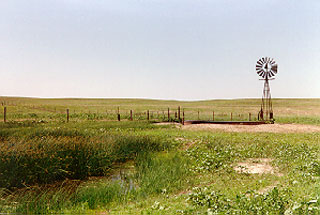
Nevens Ranch, southern edge of the Sandhills, northwest of Paxton, Nebraska.

Sunset over Kingsley Dam, Keith County, Nebraska.
